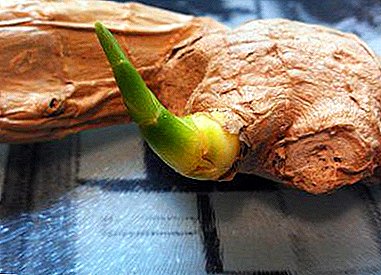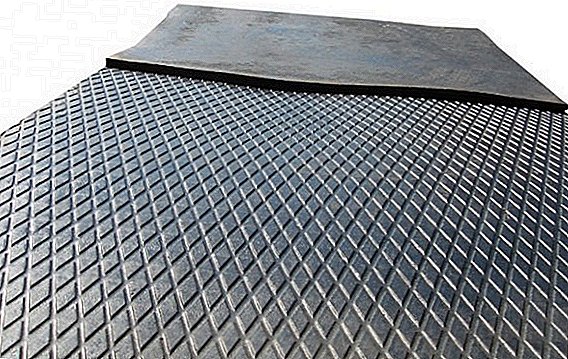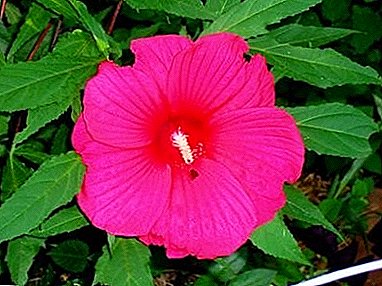
Having heard about the beneficial properties of ginger, you bought an exotic root, but because of the unusual sharp taste could not use it immediately. A few days later he gave signs of life.
What to do? Plant it in the ground or eat it? In this article, you will learn how to deal with this situation and prevent germination.
Some deliberately buy healthy ginger root and wait for it to germinate in order to plant it in a pot or, if the climate allows it, then in open ground and get their own crop on their plot.
When can the rhizome give shoots?
On each rhizome there are so-called eyes - The beginnings of real, above-ground shoots. Under favorable conditions, these eyes swell, become bright green, and soon out of them appear elongated sharp shoots, resembling arrows onions. In such cases, it is said that ginger sprouted.
Can this be avoided?
 In order not to be faced with the choice of “plant or plant” again, store the ginger correctly. In the refrigerator, the likelihood of escape awakening decreases, but still remains.
In order not to be faced with the choice of “plant or plant” again, store the ginger correctly. In the refrigerator, the likelihood of escape awakening decreases, but still remains.
To completely eliminate this possibility, peel the root of the skin (remove a very thin layer of skin, as under it the most valuable substances are concentrated), cut it into small pieces, cover it with water, put it in the refrigerator.
Store chopped rhizomes for a week. Grate grated ginger and freeze, or pour vodka. However, with any method of storage, some of the nutrients are destroyed, so it is safest to use ginger in the first days after purchase.
Is it necessary to forcibly stimulate?
If you want to grow ginger from the root, you can stimulate the growth of shoots. This is especially true for open ground. It is necessary to start germinating at the turn of February and March. For planting, purchase a smooth root with an elastic, intact skin, with many "eyes".
How to sprout?
Inventory:
- ceramic or glassware;
- container with warm water;
- sharp knife;
- crushed wood or activated charcoal or ash;
- potassium permanganate;
- low container;
- drainage material (for example, expanded clay or broken brick);
- ready soil for seedlings or a mixture of sod land with humus (3: 2).
The germination process:
- Wash the rhizome with warm water and soak it for a week in a ceramic or glass dish in a warm, humid room, such as near a battery.
- Before planting, place it in warm water for several hours.
- Disinfect the knife, cut the rhizome into pieces, so that each of them had two eyes.
- Dust the slices with coal or ashes (you can treat them with potassium permanganate when planted in a pot) and dry them.
- Place a drainage layer on the bottom of the container, pour the soil on top.
- On its surface spread the prepared roots with eyes up.
- Sprinkle them with a layer of soil 2-2.5 cm and pour it well with warm water.
How to plant sprouted?
How to understand that sprouted ginger is ready for planting? Green shoots should appear from the ground, and warm weather should be established outside. Further we will tell about how to plant a root if it gave a sprout.
In open ground
 In Russia, ginger can be grown in the southern regions and in the middle lane. From germination to harvest takes about 8 months. In temperate climates, it is better to grow it in a greenhouse or greenhouse. Ginger loves partial shade. Protect the landing site from the wind. The soil should be loose, breathable, well drained.
In Russia, ginger can be grown in the southern regions and in the middle lane. From germination to harvest takes about 8 months. In temperate climates, it is better to grow it in a greenhouse or greenhouse. Ginger loves partial shade. Protect the landing site from the wind. The soil should be loose, breathable, well drained.
If you have germinated a rhizome in advance, then the seedlings can be planted in the furrows:
- Create several furrows on the garden with a row spacing of about 65 cm.
- Water them with a stream of warm water.
- Plant the seedlings in the furrows at a distance of about 15 cm from each other and sprinkle them with soil.
- Mulch the soil with humus or dry peat.
Ginger roots can be planted in open ground and without prior germination. This method is suitable for the southern edges, where it takes about six months to harvest the crop. Prepare the rhizome for planting as described above (keep it warm, cut, process the cuts with coal and dry them). Then follow these steps:
- Dig a hole about 20 cm deep.
- Put on the bottom of one layer of small stones and sand, 2 cm each.
- Cover the wells with soil.
- Prepared pieces of rhizomes are buried in the ground for 2-3 cm eyes up.
- Liberally pour landing.
At home
Of course, ginger root can "arbitrarily" germinate at any time of the year, but in order to get a crop, it is best to plant in spring or winter. The window sill should be well lit, but ginger does not tolerate direct sunlight.
As in the open ground, the soil should pass moisture and air well. Choose a wide, shallow plastic pot with drain holes. Prepare the rhizome and proceed to planting:
- At the bottom of the pot lay a layer of drainage - expanded clay, pebbles, broken brick, egg shells, wood bark or even dry tangerine peels. The larger the holes in the pot, the larger the material should be.
- Prokalite soil in the oven and pour it into the pot.
- Spread the rhizome pieces on the surface of the soil with the kidneys upward at a distance of 3 cm from each other, pour water well and sprinkle with earth, without closing the eyes.
Possible difficulties
Ginger is unpretentious, and special difficulties care for him will not be. But remember that from the stagnation of moisture the root can rot, and the plant will die. Do not overdo it with watering. Protect the landing from wind and draft. In addition, if ginger is grown in the open field, the size of the ripened tubers is smaller than the north of the region. But this does not affect the taste and medicinal properties of the crop.
How else can you use?
Unlike potatoes, sprouted ginger does not contain toxic compounds.
If you do not want to mess around with the planting, use it as usual - rub it on a grater and add to tea (it is good to throw a few berries of frozen sea buckthorn into such a drink), boil jam or pickle. You can make a face and body mask out of it. Of course, the germinated rhizome contains less nutrients, but it can not harm.
Now you know what to do with sprouted ginger root. Plant it in a pot, and if the climate of your edge allows it, then in open ground. Or maybe you are eager to specifically germinate rhizome? Then run to the supermarket and select a healthy spine.












